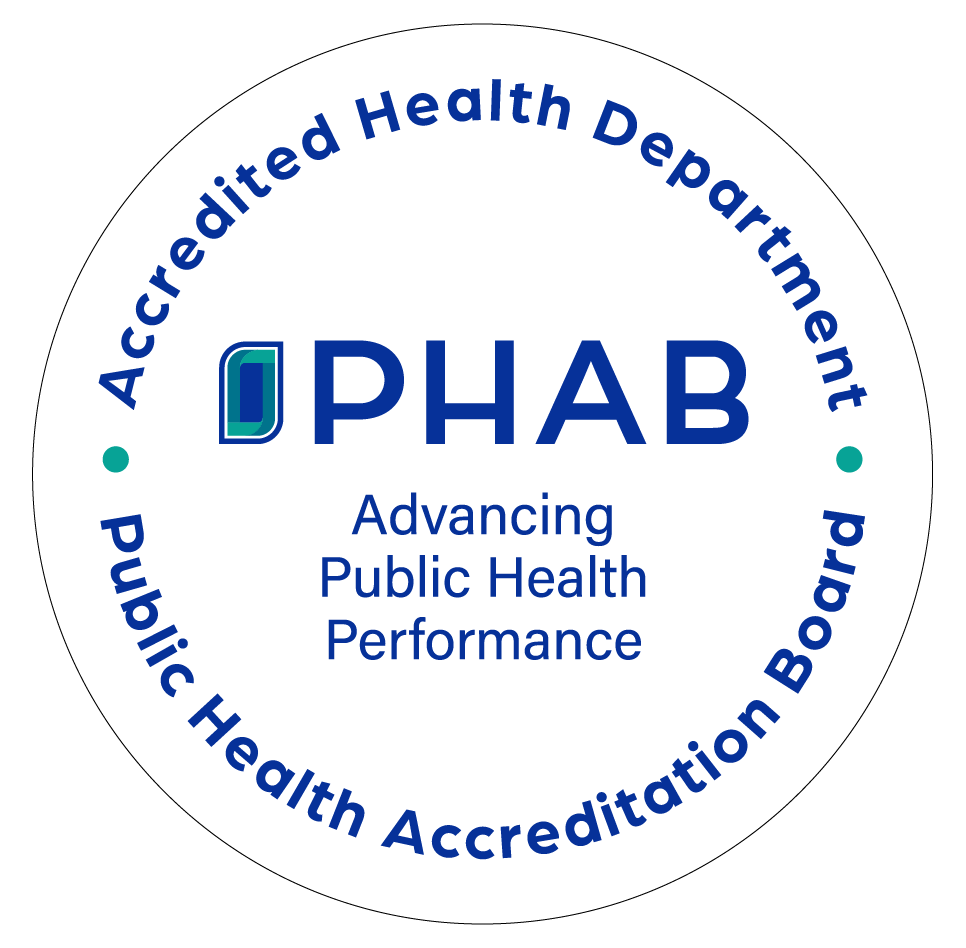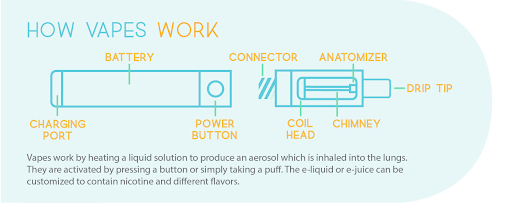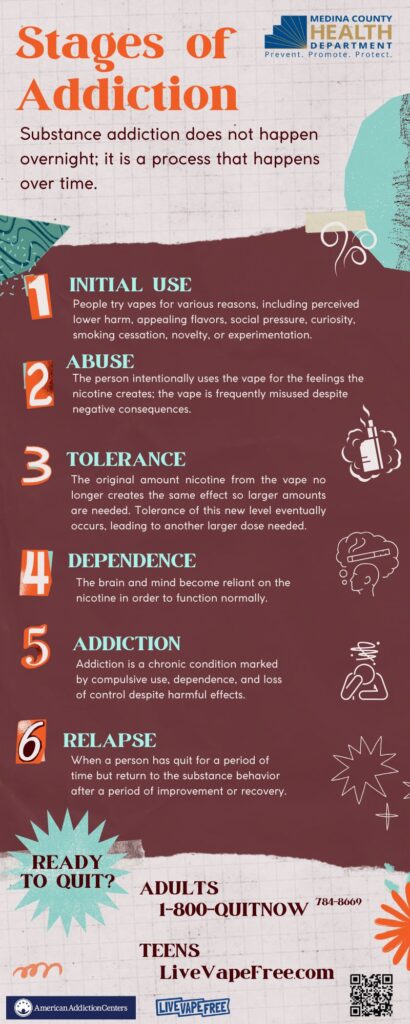Vaping was originally invented as an alternative for adult smokers in an attempt to find a less dangerous product. Unfortunately, only about 15% of people who used vapes to quit smoking were able to actually quit. Numerous studies show that using vapes is an inconsistent method to quit smoking.
Data shows us that the majority of people vaping have been youth–not adults who are trying to quit. When vaping hit its peak of popularity in 2019, over 37% of youth were vaping. These were youths who were never interested in smoking cigarettes. Vaping has addicted a whole new generation to nicotine and has undone years of work in tobacco prevention.
Vaping and smoking both deliver nicotine and other substances to your lungs. E-cigarettes heat a liquid to create an aerosol, while cigarettes burn tobacco, producing smoke.
How do vapes work:
Vapes use a battery to heat a liquid that has nicotine, propylene glycol, vegetable glycerin, and flavorings. Because vaping has only been common for about 10 years, there is still much we don’t know about the long-term health effects of vaping these ingredients.
To sign up for a tobacco education course, please complete and submit the registration form
For more information on programs provided by the Medina County Health Department, please contact 330-723-9688, option 2 and ask to speak with a Tobacco Health Educator.
Vaping can cause significant health risks, including potential for lung damage, addiction, and negative impacts on cardiovascular and mental health, particularly among young people. Most vaping products contain nicotine, a highly addictive substance.
Effects on the lungs:
E-liquid, also known as vape juice or vape oil, is turned into a mist that is inhaled and coats the lungs with harmful chemicals. Elements of the vapor can get deep down in the lungs as it is inhaled.
- Known chemicals in e-liquid include:
- Diacetyl – a food additive, used to deepen e-cigarette flavors and is known to damage small passageways in the lungs.
- Formaldehyde – a toxic chemical that can cause lung disease and contribute to heart disease.
- Acrolein – most often used as a weed killer, this chemical can also damage lungs.
- Vitamin E is often added to e-liquid. While Vitamin E is safe as an oral supplement or a lotion for the skin, it is an irritant when inhaled and can cause severe lung damage.
Effects on the brain:
Nicotine, found in most vapes, negatively impacts brain development and functions:
- Decreases ability to pay attention making it harder to learn
- Affects memory and concentration
- Causes/worsens mood swings
- Increases anxiety and depression
- Increases risk of eating disorders
- Slows down impulse controls (reaction time)
People under the age of 25 are more at risk due to the brain still developing.
- Raises the risk of addiction
- Increases risk of nicotine overdose
- Leads to a greater chance of experimenting with other substances such as cigarettes or other drugs
Nicotine addiction leads to withdrawal symptoms:
- Cravings
- Depression
- Anxiety
- Problems focusing
- Problems sleeping
Other effects:
Vaping poses serious risks, including lung and organ damage, breathing issues, addiction, and more. Many people assume vaping is “safer” than smoking, but it is not safe.
- Asthma: Vaping increases the risk of developing asthma and other lung conditions. It can also worsen existing asthma.
- Lung scarring: Some flavorings contain diacetyl, a chemical linked to bronchiolitis obliterans (“popcorn lung”), which causes permanent lung scarring.
- Organ damage: Nicotine and other chemicals in e-liquids can harm your lungs, heart, and brain. Nicotine can impair brain development, raise blood pressure, and narrow arteries.
- EVALI (E-cigarette or Vaping Product Use-Associated Lung Injury): This serious lung condition causes widespread damage, with symptoms like coughing, shortness of breath, and chest pain. EVALI can be fatal.
- Addiction: Nicotine is highly addictive, altering brain chemistry and making it hard to quit. Even “nicotine-free” e-liquids often contain small amounts of nicotine.
- Cigarette Smoking: Vaping can lead to cigarette smoking, which exposes users to even more harmful chemicals.
- Second-hand exposure: While vaping doesn’t produce smoke, bystanders still inhale nicotine and other chemicals.
- Explosions: Vaping device batteries can explode, causing serious burns and injuries.
- Cancer: Some e-liquid ingredients are known to cause cancer.
Vaping while pregnant harms the developing fetus:
- Increases chance of baby being born underweight
- Increases risk of early (preterm) birth
- Permanently damages the baby’s brain development as well as other organs
Research is still being conducted to fully understand the effects of vaping while pregnant on the mother and fetus.
Nicotine addiction is when the body becomes used to having nicotine (builds tolerance) and over time releases less dopamine when you vape, meaning that you need more to get the same effect. This causes physical cravings for nicotine and a chemical addiction.
- Nicotine is highly addictive, and floods your brain with 100% more dopamine compared to normal levels. Your body can start relying on nicotine very quickly.
- Repeating vaping over and over again and building routines around vaping can also create habits or behavioral dependence on nicotine.
- Dependence on nicotine leads to cravings, tolerance, and withdrawal symptoms when not using the product.
Many people say that nicotine addiction is one of the hardest addictions to break, but it can be done. Usually it takes 3 months after quitting for your brain’s dopamine receptors to go back to normal.
Nicotine addiction happens when you need nicotine and can’t stop using it. You can take this quiz to see if you might be addicted to nicotine.
Some signs to look for:
- You have withdrawal symptoms when you try to quit
- Strong cravings
- Mood swings
- Irritability
- Restlessness
- Increased hunger
- Depression
- Difficulty concentrating
- Constipation or diarrhea
- You keep vaping even though you are experiencing health problems because of vaping
- You stop hanging around with friends who don’t let you vape around them or friends who ask you to quit
Side effects of addiction (too much nicotine)
Having too much nicotine can lead to many symptoms, known as nicotine overdose or nic-sick. Nic-sick symptoms within 15 minutes of vaping can be:
- Nausea or vomiting
- Stomach ache and loss of appetite
- Increased heart rate and blood pressure
- Headache
- Mouth watering
- Quick, heavy breathing
- Dizziness or tremors
- Confusion and anxiety
After 30 minutes, nic-sick symptoms can be:
- Diarrhea
- Shallow breathing
- Slower heartbeat and blood pressure
- Extreme fatigue
- Weakness, slow reflexes, or unable to control muscles
- Pale skin
Go to a hospital or call 911 right away if symptoms get worse.
Nicotine overdose can lead to seizures, respiratory failure, cardiac arrest, breathing difficulties or even coma. Talk with your doctor if you vape – no matter how much you vape (there is no safe level of nicotine).
Using a combination of medication and counseling can triple your chances of successfully quitting.
Gradual Quit:
Nicotine addiction happens when you need nicotine and can’t stop using it. You can take this quiz to see if you might be addicted to nicotine.
- Awareness: Create a weekly calendar noting when you vape, how much you vape, and how often you vape.
- Pick a day to start your quit journey.
- Create a schedule of reduced use over a specific time period:
- Cut down on nicotine gradually
- Control your nicotine level by using a refillable vape
- Pay attention to how much you are using the vape and how you feel
- Extend time between vaping sessions:
- Push yourself through cravings by taking a walk, exercise, drinking water, reading, watching TV – anything that you can use to distract yourself until the craving passes.
- Create vape-free spaces at home and at work:
- List places where you would normally vape or where you might feel pressure to vape – stay away from these place or make them vape-free
- Try to go to places where you do not feel pressure to vape. As you decrease your vape use, gradually expand areas in your environment where you know you can control your cravings or temptation to vape.
- Tell others that you are quitting; ask them to not vape around you.
One Step Quit:
- Pick a day and stop
- Talk with a quit counselor at no charge
- Talk with your healthcare provider about nicotine replace therapies (NRTs)- over the counter and prescription strength products
For more information, go to our quitting page.
If you currently smoke and want to use vaping as a way to quit smoking, there are a few things to know first:
- Dual use (smoking and vaping) may damage the lungs more than either one separately. Avoid using both products.
- On average people end up smoking more than before
- Dual use puts you at higher risk for difficulty breathing and heart issues
- People who smoke and vape report feeling worse overall
- It’s important to create a plan to quit vaping. Vaping has risks and can harm the lungs.
- The research is mixed on if vaping works as a way to quit. While some people do successfully stop smoking, 80% continue to vape. Some studies show that vaping can be more addictive than smoking, which can make it harder to quit vaping later.
- If you do choose to use vaping to quit smoking, here are a few things to consider:
- The best way to quit smoking is to combine medication and counseling, which gives you a 3 times higher chance of success with your quit attempt.
- Figure out how much nicotine you currently use
- Do the math on how much nicotine would be in your vape (for example one 200 puff Juul Pod at 5% nicotine has about the same amount of nicotine as a whole pack of cigarettes)
- Create a plan for when you plan to quit vaping after you’ve successfully quit smoking.
- Some people choose to gradually reduce the amount of nicotine in their vape over time so that eventually they have zero nicotine in their vape.
Many companies advertise non-nicotine vapes as an alternative. Here are some things to know:
- The lungs are very sensitive and easily damaged. Even without nicotine, the chemicals in vapes can still damage the lungs and are not recommended.
- Some ingredients like vitamins, caffeine, or essential oils may be safe in foods or on the skin, but are not safe for your lungs, especially when heated.
- Most vapes use a metal coil to heat the liquid to turn it into an aerosol that goes into the lungs. Over time, heavy metals such as lead, nickel, and chromium from the coil leach into the liquid and then can be toxic to the lungs.
Vitamin vapes and Personal Essential Oil Diffusers:
- While companies may claim that vitamin vapes or essential oil diffusers are safer than nicotine vapes, these products do have risks.
- Essential oil vape pens and vitamin vapes use the same process as nicotine vapes to heat a liquid to a very high temperature before it gets into the lungs. At very high temperatures, essential oils can become volatile organic compounds which are dangerous to human health.
- Even essential oil companies do not recommend vaping essential oils or heating them to high temperatures.
- There is no evidence showing that inhaling vitamins is a safe or consistent method of absorbing vitamins.
- In 2019, 60 individuals died due to EVALI, which we now believe was caused by Vitamin E acetate.
- Most adults can get the needed amount of vitamins through eating healthy foods.
Side Effects
There is no safe level of vaping; there are side effects to your health whether or not vape fluid contains nicotine. Here’s what we know:
- Heated vape fluid causes irritation in the mouth and airways.
- Propylene glycol and glycerol (clear, sweet, colorless alcoholic compounds) may cause cancer.
- E-juice flavorings cause an inflammatory response to certain white blood cells which affects the immune system.
- Even without nicotine, vape fluids can damage or kill lung cells that are needed to defend your body from toxins, germs, and allergens you breathe in.
- Flavoring additives harm blood cells which affects your heart health, leading to high blood pressure, diabetes, and heart disease.
Vapes are considered hazardous waste because they contain lithium Ion batteries and the e-liquid can also contain toxins such as nicotine that can leach into soil and groundwater.
Lithium ion batteries can be very explosive when damaged and can cause fires in homes or on garbage trucks. It is very important to dispose of them properly.
For Individuals:
- You can safely dispose of vapes at Household Hazardous Waste disposal sites through Medina Solid Waste District
- Household Hazardous Waste can be taken for free to 8730 Lake Rd on Monday and Wednesday, from 8:00 am to 4:30 pm and Saturdays from 7:00 am to noon.
For Schools or Businesses:
- You can contact the businesses on this list to coordinate disposal of products with batteries.
- Household Hazardous Waste – Contact List for Businesses
If you have a young person in your life that vapes, encourage them to quit and offer support throughout the quit process.
- Nearly 55% of people ages 15-36 who vape want to quit.
- Try to focus on encouraging them to build other strong coping skills so that their quit attempt is more successful.
For more information visit our parents page.
- Cigarette and e-cigarette dual use and risk of cardiopulmonary symptoms in the Health eHeart Study
- Build My Quit Plan | Smokefree Teen
- Blowing Smoke: The Risks of Essential Oil Vape
- Constipation After Quitting Smoking
- E-cigarettes and Vaping | Health Risks of E-cigarettes
- E-Cigarettes are More Addictive than Traditional Cigarette
- Electronic cigarettes for adults with tobacco dependence enrolled in a tobacco treatment program: A pilot study
- Essential Oil Vape Pens: Don’t Be Fooled
- The Facts about Vaping – Respect Your Brain
- Flavorings in Tobacco Products Induce Endothelial Cell Dysfunction
- Hospitalizations and Deaths Associated with EVALI
- How much nicotine is in JUUL?
- How to dispose of vapes properly
- How Well Designed Is the Human Lung
- Is Vaping Okay During Pregnancy?
- Kids and Smoking
- Long-Term Effects of Nicotine on the Brain
- Measuring Cigarette Smoking-Induced Cortical Dopamine Release
- Nicotine Addiction
- Nicotine dependence – Symptoms and causes
- Potential Harmful Health Effects of Inhaling Nicotine-Free Shisha-Pen Vapor: A Chemical Risk Assessment of the Main Components Propylene Glycol and Glycerol
- Prevalence and uptake of vaping among people who have quit smoking
- Quitting Starts Now. Make Your Quit Plan
- Researchers Find Toxic Metals in E-Cigarettes
- Tobacco Industry Marketing
- Treating Tobacco Use and Dependence
- 2019 National Youth Tobacco Survey Shows Youth E-cigarette Use at Alarming Levels
- Vaping (E-Cigarettes)
- Vaping and Quitting | Smoking and Tobacco Use
- Vaping and Smoking: Are You Doing Both?
- Vaping Essential Oils: Side Effects, Precautions, and Is It Safe?
- Vaping to Quit Smoking? Here’s the Truth About E-Cigarettes
- Vaping: What You Need to Know (Teens)
- Vaping Without Nicotine: Are There Still Side Effects?
- Vitamin Vape – FDA
- Vitamin Vaping Raises Wariness among Scientists
- What Are Carcinogens and How Do They Increase Your Risk of Cancer?
- What It Means to Be “Nic-Sick”
- Yuck! Don’t vape that



